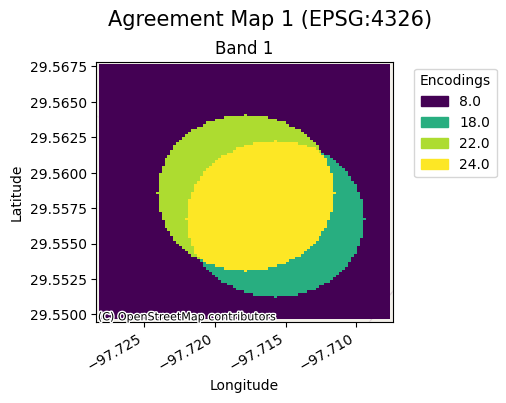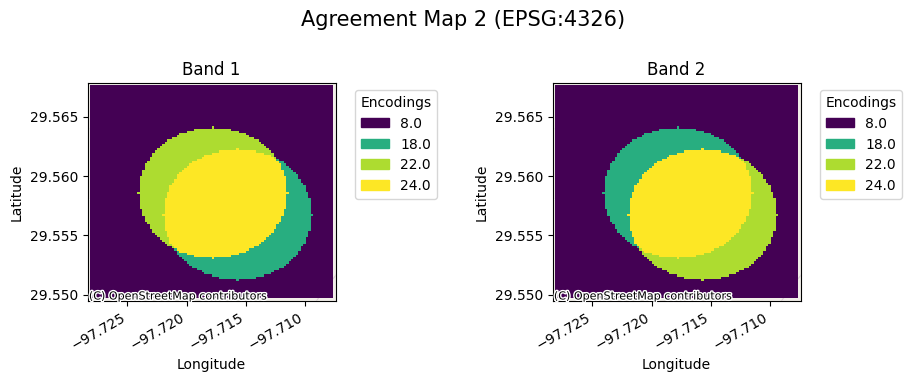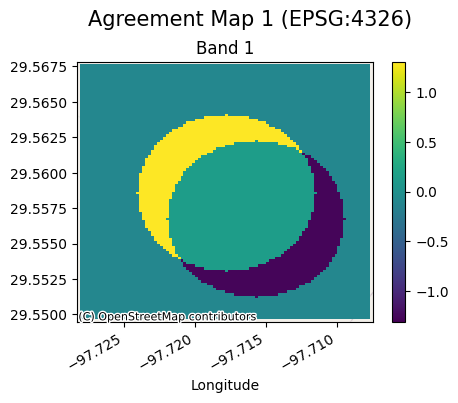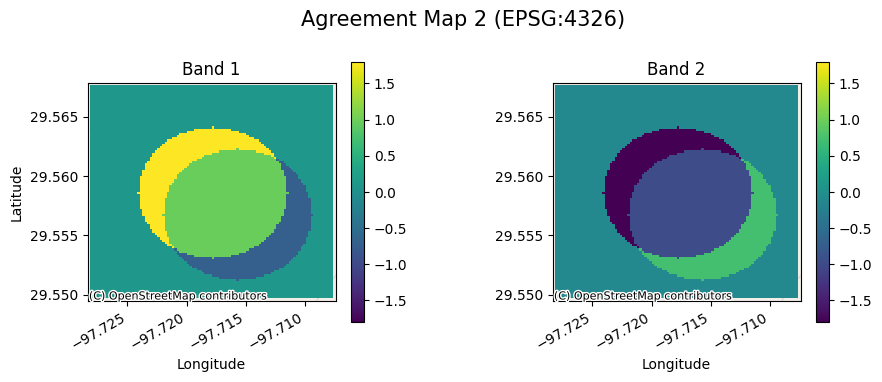
Catalog Comparisons
[1]:
import pandas as pd
import rioxarray as rxr
from gval.catalogs.catalogs import catalog_compare
Initializing Catalogs
The cataloging functionality was designed to easily facilitate batch comparisons of maps residing locally, in a service, or in the cloud. The format of such catalogs are as follows:
[2]:
TEST_DATA_DIR = './'
candidate_continuous_catalog = pd.read_csv(f'{TEST_DATA_DIR}candidate_catalog_0.csv')
benchmark_continuous_catalog = pd.read_csv(f'{TEST_DATA_DIR}benchmark_catalog_0.csv')
candidate_categorical_catalog = pd.read_csv(f'{TEST_DATA_DIR}candidate_catalog_1.csv')
benchmark_categorical_catalog = pd.read_csv(f'{TEST_DATA_DIR}benchmark_catalog_1.csv')
Candidate Catalog
[3]:
candidate_categorical_catalog['catalog_attribute_1'] = [1, 2]
candidate_categorical_catalog
[3]:
| map_id | compare_id | agreement_maps | catalog_attribute_1 | |
|---|---|---|---|---|
| 0 | ./candidate_categorical_0.tif | compare1 | agreement_categorical_0.tif | 1 |
| 1 | ./candidate_categorical_1.tif | compare2 | agreement_categorical_1.tif | 2 |
The catalog should have columns representing: 1. An identifier of a candidate map, (in this case compare_id) 2. The location of the candidate map, (in this case map_id) 3. The name of the agreement map to be created named agreement_maps
Benchmark Catalog
[4]:
benchmark_categorical_catalog['catalog_attribute_2'] = [3, 4]
benchmark_categorical_catalog
[4]:
| map_id | compare_id | catalog_attribute_2 | |
|---|---|---|---|
| 0 | ./benchmark_categorical_0.tif | compare1 | 3 |
| 1 | ./benchmark_categorical_1.tif | compare2 | 4 |
Similar to the previous catalog, the benchmark catalog should have columns representing: 1. An identifier of a candidate map, (in this case compare_id) 2. The location of the candidate map, (in this case map_id)
Categorical Catalog Comparison
When compare_type is set to ‘categorical’ the catalog will be run as categorical comparisons. See arguments and output below for the comparison metrics:
[5]:
arguments = {
"candidate_catalog": candidate_categorical_catalog,
"benchmark_catalog": benchmark_categorical_catalog,
"on": "compare_id",
"map_ids": "map_id",
"how": "inner",
"compare_type": "categorical",
"compare_kwargs": {
"metrics": (
"critical_success_index",
"true_positive_rate",
"positive_predictive_value",
),
"encode_nodata": True,
"nodata": -9999,
"positive_categories": 2,
"negative_categories": 1
},
"open_kwargs": {
"mask_and_scale": True,
"masked": True
}
}
agreement_categorical_catalog = catalog_compare(**arguments)
agreement_categorical_catalog.transpose()
[5]:
| 0 | 1 | 2 | |
|---|---|---|---|
| map_id_candidate | ./candidate_categorical_0.tif | ./candidate_categorical_1.tif | ./candidate_categorical_1.tif |
| compare_id | compare1 | compare2 | compare2 |
| agreement_maps | agreement_categorical_0.tif | agreement_categorical_1.tif | agreement_categorical_1.tif |
| catalog_attribute_1 | 1 | 2 | 2 |
| map_id_benchmark | ./benchmark_categorical_0.tif | ./benchmark_categorical_1.tif | ./benchmark_categorical_1.tif |
| catalog_attribute_2 | 3 | 4 | 4 |
| band | 1 | 1 | 2 |
| fn | 844.0 | 844.0 | 844.0 |
| fp | 844.0 | 844.0 | 844.0 |
| tn | 5939.0 | 5939.0 | 5939.0 |
| tp | 1977.0 | 1977.0 | 1977.0 |
| critical_success_index | 0.539427 | 0.539427 | 0.539427 |
| true_positive_rate | 0.700815 | 0.700815 | 0.700815 |
| positive_predictive_value | 0.700815 | 0.700815 | 0.700815 |
We can see the agreement maps below (and why the metrics are similar as the datasets were essentially equivalent):
[6]:
for ag_map in agreement_categorical_catalog['agreement_maps'].unique():
rxr.open_rasterio(ag_map, mask_and_scale=True).gval.cat_plot(
title=f'Agreement Map {int(ag_map.split("_")[-1][0]) + 1}'
)


Continuous Catalog Compare
The continuous catalogs are as follows:
[7]:
candidate_continuous_catalog['catalog_attribute_1'] = [1, 2]
candidate_continuous_catalog
[7]:
| map_id | compare_id | agreement_maps | catalog_attribute_1 | |
|---|---|---|---|---|
| 0 | ./candidate_continuous_0.tif | compare1 | ./agreement_continuous_0.tif | 1 |
| 1 | ./candidate_continuous_1.tif | compare2 | ./agreement_continuous_1.tif | 2 |
[8]:
benchmark_continuous_catalog['catalog_attribute_2'] = [3, 4]
benchmark_continuous_catalog
[8]:
| map_id | compare_id | catalog_attribute_2 | |
|---|---|---|---|
| 0 | ./benchmark_continuous_0.tif | compare1 | 3 |
| 1 | ./benchmark_continuous_1.tif | compare2 | 4 |
Just like before, compare_type is set to ‘continuous’ and the catalog will be run as continuous comparisons:
[9]:
arguments = {
"candidate_catalog": candidate_continuous_catalog,
"benchmark_catalog": benchmark_continuous_catalog,
"on": "compare_id",
"map_ids": "map_id",
"how": "inner",
"compare_type": "continuous",
"compare_kwargs": {
"metrics": (
"coefficient_of_determination",
"mean_absolute_error",
"mean_absolute_percentage_error",
),
"encode_nodata": True,
"nodata": -9999,
},
"open_kwargs": {
"mask_and_scale": True,
"masked": True
}
}
agreement_continuous_catalog = catalog_compare(**arguments)
agreement_continuous_catalog.transpose()
[9]:
| 0 | 1 | 2 | |
|---|---|---|---|
| map_id_candidate | ./candidate_continuous_0.tif | ./candidate_continuous_1.tif | ./candidate_continuous_1.tif |
| compare_id | compare1 | compare2 | compare2 |
| agreement_maps | ./agreement_continuous_0.tif | ./agreement_continuous_1.tif | ./agreement_continuous_1.tif |
| catalog_attribute_1 | 1 | 2 | 2 |
| map_id_benchmark | ./benchmark_continuous_0.tif | ./benchmark_continuous_1.tif | ./benchmark_continuous_1.tif |
| catalog_attribute_2 | 3 | 4 | 4 |
| band | 1 | 1 | 2 |
| coefficient_of_determination | -0.06616 | -2.829421 | 0.10903 |
| mean_absolute_error | 0.317389 | 0.485031 | 0.485031 |
| mean_absolute_percentage_error | 0.159568 | 0.202235 | 0.153235 |
We can see the continuous agreement maps below:
[10]:
for ag_map in agreement_continuous_catalog['agreement_maps'].unique():
rxr.open_rasterio(ag_map, mask_and_scale=True).gval.cont_plot(
title=f'Agreement Map {int(ag_map.split("_")[-1][0]) + 1}'
)

